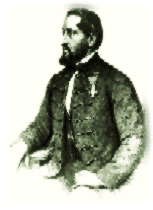|
ÁBRAHÁM GANZ (1814 - 1867) |
 |
Born in the township of Unter-Embrach, Switzerland. Ganz learned the carpentry trade, then apprenticed in foundry. During the tradesman's customary working tour he arrived in Pest in 1841. He was soon working on the construction of the Széchenyi steam mill as a mechanic. In 1844 he already had his own foundry in Buda, which quickly developed into a significant factory. He set out to manufacture chill-casting of wheels for railway carriages, and in perfecting that process he filed many patent applications. A joint enterprise developed from that factory, which operated in conjunction with various industries including electricity, machine and automobile manufacture, and became world-renowned for its inventions and technical solutions. During the War of Independence in 1848, they were engaged in casting guns and lead for bullets and cannonballs.
After the failure of the War of Independence, Ganz tried to adapt the Englishman Burn's chill-casting invention to the manufacture of wagon wheels. He continued to experiment, and patented his own invention in 1855. Many of his successes rested upon that patent. In 1865 the Emperor personally expressed his highest recognition. Two years later they celebrated manufacturing of the 100,000th chill casted wheel and three weeks after the celebration Ganz died under tragic circumstances. In his lifetime, Ganz appropriated considerable sums for the welfare of his factory workers, and established a pension and disability fund unique in Hungary at that time.
Ganz-Jendrassik ship engine
Danube-ocean shipping in the 1930s became inseparable from György Jendrassik's name, the ships were furnished and operated with engines of his design. The engine produced 400 hp at 800 rev./min. Because of the high engine speed, a permanent reduction device had to be fitted between the engine and propeller. Since the Ganz factory was not equipped to forge such a large crank shaft, it was cast in three pieces. The fuel injection pump's cam and lever permitted revolution in only one direction; therefore he solved the pneumatic reversing mechanism fitted to the split pump case in such a way that either at forward or reversed rev the pump's direction of revolution should not change. The engines for the Danube-ocean ships were fitted in pairs by mirror image arrangement.

